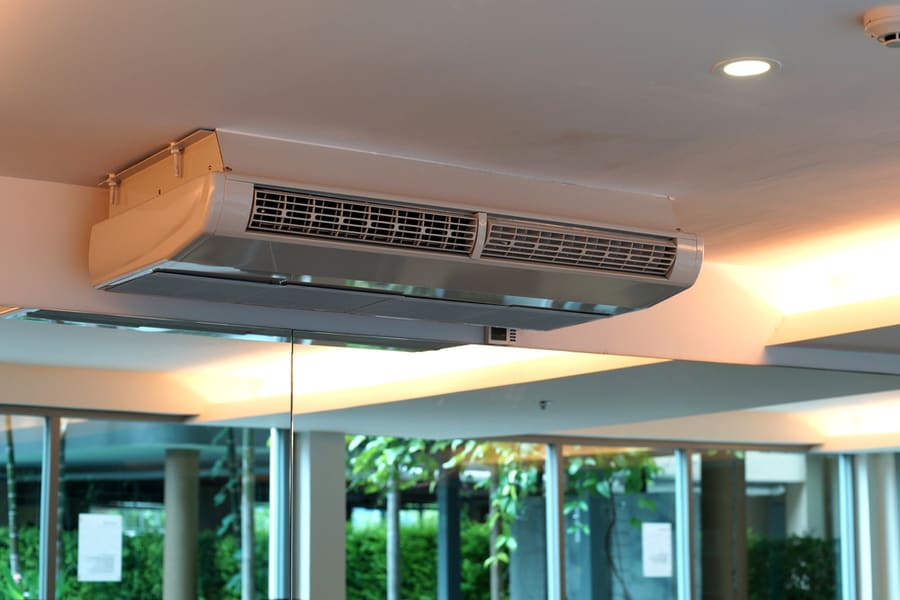
All of us are constantly using air conditioners in our houses. But have you ever wondered what goes on in it?
How the hot air suddenly cools down, or how is the heat removed through air conditioning? Well, there are several steps involved in the whole process.
The warm air goes through various processes for heat removal.
- First, the refrigerant in the evaporator coils absorbs the warm air from the room and cools it down.
- Then, the compressor helps eliminate the heat from the refrigerant and throws it outdoors.
In this article, let’s talk more about the functioning of an air conditioner and how heat is removed through it.
Different Parts of an Air Conditioning Unit

If you’re unaware of the different parts of an air conditioning unit, you might not be able to get its actual working mechanism.
So, let’s familiarize ourselves with the main components of an AC unit.
1. Refrigerant

If you want to know about the functioning of ACs, you need to know what a refrigerant is. Well, in simple terms, it’s just a special type of fluid required for cooling purposes.
With the help of a refrigerant, the heat is absorbed from the indoor areas and thrown out. This is possible as a refrigerant can easily change its state from liquid to vapor and vice versa at different temperatures.
2. Evaporator Coils
Evaporator coils are one of the most important components in an air conditioning unit. Due to the combination of evaporator coils and refrigerant, the hot indoor air cools down.
The evaporator coils contain cold refrigerant. So, when the hot air passes through the coils, the heat is absorbed.
Furthermore, the refrigerant starts turning into vapor once it absorbs the heat.
3. Condenser Coil

The function of the condenser coil is exactly opposite to that of the evaporator coils. Unlike the evaporator coils with cold refrigerant, the condenser coil contains hot refrigerant.
Now, with the help of an indoor condenser fan, the hot refrigerant releases the heat back into the outdoor air (as heat travels from a hot to a cold environment).
Due to this reason, the hot refrigerant cools down and turns into a liquid again. Finally, the liquid refrigerant moves to the expansion valve.
4. Compressor

A compressor is required to increase the pressure and temperature of the refrigerant. When you compress the refrigerant, both its pressure and temperature increase too.
It’s necessary to compress the refrigerant and increase the temperature to transfer heat into the cold outer surroundings. Thus, cooling down the refrigerant again.
5. Expansion Valve

Remember that it’s still quite hot even after the compressor has cooled down the refrigerant.
So, unlike a compressor that pressurizes the refrigerant, the expansion valve depressurizes it. This causes the overall temperature to reduce and allows the refrigerant to cool down again.
The cool refrigerant is then pushed into the evaporator coil.
How Is Heat Removed Through Air Conditioning?

Now that you’re aware of the main components of an AC let’s understand how the heat is removed through it.
Step #1: The Heat Gets Absorbed
In this step, the evaporator coils consist of a cold refrigerant.
Hence, when the warm indoor air passes through these coils, the heat moves from the warm air to the cool refrigerant. This causes the air to cool down. Then, the cool air is distributed throughout the room.
At the same time, the liquid refrigerant absorbs heat and changes into a gaseous state. Then, it travels to the compressor.
Step #2: Compressor Increases the Pressure and Temperature
Increasing the temperature of the refrigerant is necessary to release the heat back into the outside air.
Now, this process is facilitated with the help of a compressor. As the name suggests, a compressor compresses the refrigerant. This leads to an increase in the refrigerant’s temperature.
Step #3: The Heat Is Removed Outside
Once the temperature increases, the heat energy moves from a warm area (the refrigerant) to a cold area (the outdoor air). This way, the heat is removed outside.
Simultaneously, the vaporized refrigerant loses its heat and turns back into a liquid form.
Step #4: Refrigerant Cools Down Again
Before the refrigerant is returned to the evaporator coils, it must become cold.
Hence, this step passes the refrigerant from the compressor to the expansion valve.
The expansion valve works by reducing the pressure and the temperature of the refrigerant. This way, the refrigerant cools down again. Then, the cooled refrigerant is sent back to the evaporator coils.
Step #5: The Cycle Is Repeated
The whole process is repeated until the room reaches the desired temperature.
How Much Heat Can an Air Conditioner Remove?

Generally, most HVAC technicians say that an air conditioner can reduce the room temperature by 20 Degrees Fahrenheit.
For example, if your room’s current temperature is 100 Degrees Fahrenheit, you can bring it to 80 Degrees Fahrenheit.
Note that requiring it to go lower can affect your air conditioner’s efficiency by increasing its load.
How To Increase the Efficiency of Air Conditioning?

Although you cannot decrease the temperature by more than 20 Degrees Fahrenheit, there are still ways to increase the AC’s efficiency. Here are some of the tips that I love.
Tip #1: Keep Hot Objects Away From the Thermostat
If you have any warm objects, like lamps or iron, near the thermostat, you should keep them away. It is because the thermostat might sense that your room requires more cooling. Thus, the AC system will work harder for no reason.
Tip #2: Don’t Keep Curtains Open During Hot Periods
Keeping curtains and blinds open during hot times, like the afternoon, is counterproductive if your AC is turned on. This is because the heat from the outside will continue to warm your room, and the AC will have to work more to remove it.
Tip #3: Keep the Air Conditioning Unit Clean
You should always clean or replace the AC filters every month or two. Clogged filters can reduce the efficiency and cooling power of your AC.
Apart from that, it’s also necessary to clean the condenser unit located outside and the indoor vents.
Takeaway
The whole heat removal process through air conditioning is about the various states of the refrigerant and the temperature difference.
It would help if you remembered that heat transfers from hot to cold surfaces. Hence, the evaporator coils, expansion valve, and compressors work by increasing and decreasing the refrigerant temperature for heat removal.
Frequently Asked Questions
Which Part of the Air Conditioning System Removes Heat From the Air?
The condenser in the AC system increases the refrigerant’s temperature and removes the heat energy from it to the outdoor environment.
Which Type of Heat Transfer Is an Air Conditioner?
The heat transfer in an air conditioning system is convection-type, involving the movement of gases or fluids.












